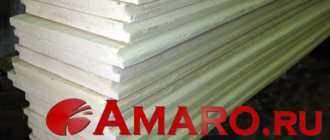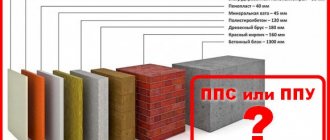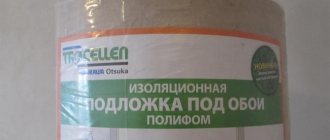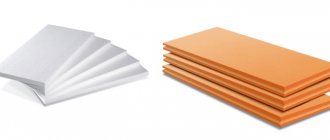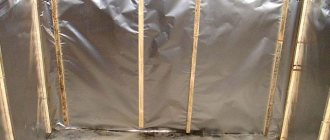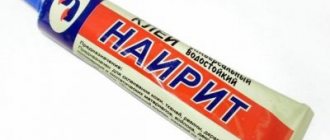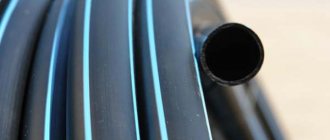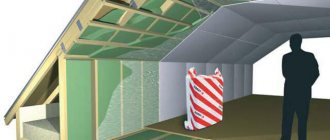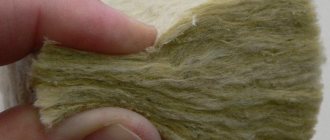What is polyurethane foam (hard modification)?
Polyurethane foam Is actually a group of materials belonging to the category of plastics, which are made on the basis of polyurethanes. The structure of the corresponding materials contains a significant proportion of cavities filled with air - pores or bubbles. Polyurethane foam was invented in the 1930s. Soon he began to be actively involved in various areas of economic activity.

Polyurethane foam
The "classic" polyurethane foam is most often understood as its solid variety. This material is actively used as an element of thermal insulation in the construction of residential premises. There are modifications of solid polyurethane foam, which are characterized by an operational speed of hardening and can be effectively used to give stability to individual building structures - we are talking about the so-called polyurethane foam.
Cured polyurethane foam has a high degree of chemical and thermal resistance. It is often possible to remove it from the surface on which it is distributed only mechanically. It is necessary to distinguish rigid polyurethane foam from similar materials such as polystyrene, foam latex or cellulose sponge, which have a completely different chemical composition.
Distinctive characteristics
- Manufacturing basis... Flexible polyurethane foam is produced using linear or slightly branched polyesters. Typically, the finished material has an open cell structure. Highly branched polyesters are used to make rigid materials, which form highly crosslinked polymers. The structure of the product has closed pores. For additional properties, glass fiber, glass mats and other additional components are added to the composition.
- Elasticity... Elastic polyurethane foam retains its shape much better after twisting and stretching. The material quickly returns to its original state after exposure to external forces. Elastic polyurethane foam is the most flexible building product that is used.
- Density... The average indicator of rigid polyurethane foam is 45-60 kg / m3, elastic - 8-20 kg / m3. With equal thickness, the density of the foam is higher. When creating general characteristics, you will have to spend three times more elastic material than rigid material, which is uneconomical.
- Typical technical characteristics... Elastic polyurethane foam has high thermal insulation and sound insulation. The material is characterized by dielectric and damping properties. The product adheres well to wood, metal, fabric and paper surfaces. Rigid polyurethane foam has high electrical insulation and low moisture absorption capacity.
- The cost... Elastic material is cheaper than rigid polyurethane foam. When choosing a product, you need to pay attention to the technical characteristics and properties, and not to the cost. Each material has its own scope. Only in some cases can they be replaced with each other.
What is foam rubber?
The material in question is a type of polyurethane foam - in its elastic modification. Significant volumes of foam rubber were imported into our country under the Scandinavian Porolon brand - hence the name of the corresponding product, which is common in the Russian Federation. Foam rubber is a relatively new material.On an industrial scale, it began to be produced in the middle of the 20th century, that is, a little later than the "classic" polyurethane foam.


Foam rubber
The peculiarity of foam rubber is that about 90% of its volume is air. A significant part of this volume can be very quickly replaced with water - if you substitute foam rubber under the stream or immerse it in a container with liquid. The material in question is also characterized by high resistance to deformation.
Elasticity and ability to absorb water make foam rubber one of the most useful materials in everyday life. Sponges are made from it for washing dishes and other purposes. Foam rubber is often used as a filler in the manufacture of furniture. Sometimes it is used as a heater - due to the relatively low through-air permeability.
However, the material in question has a number of disadvantages.
First of all, it is worth noting that the production of foam rubber is a very harmful process for the environment, because toxic substances are used within it. Over time, the material in question loses its useful properties - it becomes less elastic, the air layers present in it disappear. Therefore, foam rubber is most often used in those areas where it is not expected to be used too intensively or where frequent replacement of products that are made on the basis of the corresponding material is acceptable.
Foam rubber (elastic polyurethane foam)
In terms of properties, foam rubber is as close as possible to plastics and rubbers. Flexible polyurethane foam has the following characteristics:
- High strength.
- Resistance to chemicals, aggressive environments.
- Plasticity, flexibility.
- Environmental friendliness, safety.
- Low thermal conductivity.
- Poor moisture absorption.
- High resistance to mechanical and physical stress.
- Poor shrinkage during operation.
- Rapid recovery of the primary shape after unloading.
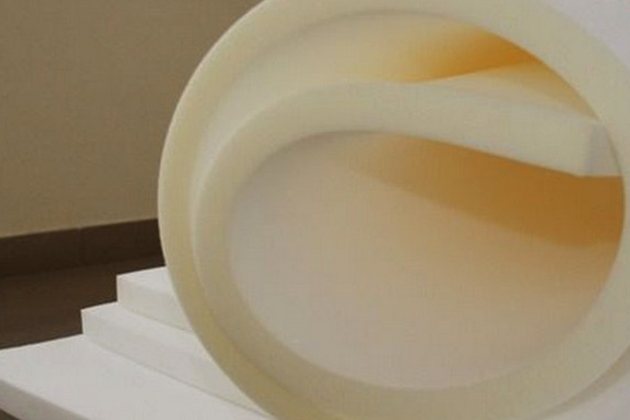

Specifications may vary, depending on the addition of additional components during production (colorants, fillers, blowing agents).
The structure is not susceptible to the reproduction of rodents, insects, microorganisms. Recycling is possible.
Table
| Polyurethane foam | Foam rubber |
| What do they have in common? | |
| Foam rubber is a soft type of polyurethane foam | |
| What is the difference between them? | |
| Solid, inelastic, has a lower percentage of air pockets in the structure | Soft, elastic, 90% air |
| Used as a building material, insulation | It is used as a material for hygiene items, furniture filler, sometimes as insulation |
Polyurethane foam ("foam rubber"), including with "shape memory" (Memory Foam)
Elastic polyurethane foam (furniture polyurethane foam) is used in the production of mattresses. There are various hardness, in spring mattresses, soft polyurethane foam is used, in springless mattresses, medium hardness and hard polyurethane foam are also used as the base of the mattress (monolithic block). The most inexpensive among all fillers in mattresses, although at the same time various types of polyurethane foam are used in mattress production, differing in quality, maximum load and, accordingly, service life, including expensive and high-quality types of polyurethane foam (artificial latex, material with a memory effect), which by their own properties and quality are not inferior even to natural latex. The good thing about this material is its good breathability due to its porous structure.
Foam rubber - is the trade name for flexible polyurethane foam, which in the Soviet Union was mainly the Scandinavian company Porolon.
Polyurethane foam (PPU) is an artificial filler of a cellular type (visually it can be compared to a sponge), it is a proven and safe material, which confirms its widespread use in everyday life, for example: sponges for washing dishes, filler in car seats, insulation in construction.Polyols are used as the main raw material for the production of polyurethane foam; when mixing a polyol and a number of modifying catalysts, a chemical reaction occurs, as a result of which the mixture is foaming. Due to the different dosage of chemical products, various types of polyurethane foam are obtained.
Highly elastic polyurethane foam (artificial latex) has improved properties of the raw materials used for the manufacture, as well as the structure of the cells. Unlike conventional elastic PU foam, which has a uniform cell structure, highly elastic PU foam has a non-uniform structure, cells have different sizes, wall thicknesses and are randomly distributed. Due to the inhomogeneous structure at a low load, smaller cells enter into work, and as the load increases, larger cells enter into work, with greater resistance to compression. Therefore, highly elastic PU foam is distinguished by high elasticity and comfort, as well as a longer service life.
The figure on the left shows the structure of the cells of conventional polyurethane foam, on the right - highly elastic polyurethane foam.
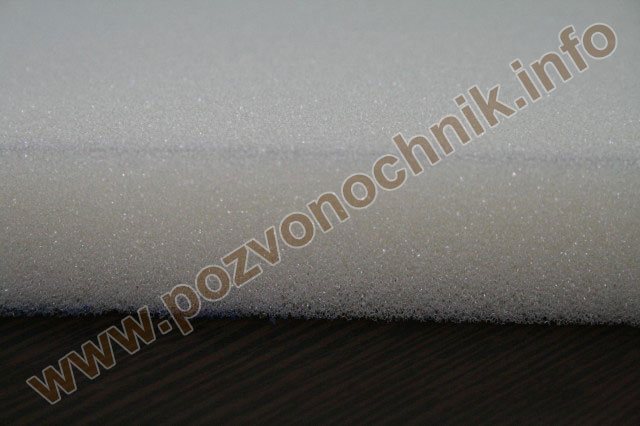

Photo of a slab made of ordinary polyurethane foam (height 3 cm) used as a filler in a mattress.


Photo of a monolithic block of highly resilient polyurethane foam (height 8 cm) called Waterform by the Italian manufacturer of Lordflex's mattresses, used as a base in a springless mattress.
Viscoelastic polyurethane foam with "shape memory" (other names: Memoriform, Memory Foam, Memorix) is an expensive and unique material with special physical and mechanical properties, characterized by slow recovery after compression. When an object (for example, a human body) is immersed in a viscoelastic foam, the foam exactly reproduces the shape of the immersed body, and after removing the load, the foam slowly returns to its original shape. Viscoelastic foam reacts to body and ambient temperature by softening with body heat and adjusting more easily to body contours. Due to this, the filler exerts the least pressure on the subcutaneous vessels and promotes better blood flow. Due to its increased density and at the same time a high level of comfort, PU foam with "memory" has a low air permeability compared to conventional PU foam. Other characteristics of viscoelastic foam are vibration damping and shock absorption - products made of viscoelastic foam absorb up to 90% of the applied energy. Viscoelastic PU foam is used in many areas of industry, including the space industry (it was first used by NASA - the US National Aeronautics and Space Administration).


Photo of a plate made of viscoelastic polyurethane foam with "memory" (height 4 cm) used as a filling in a mattress.
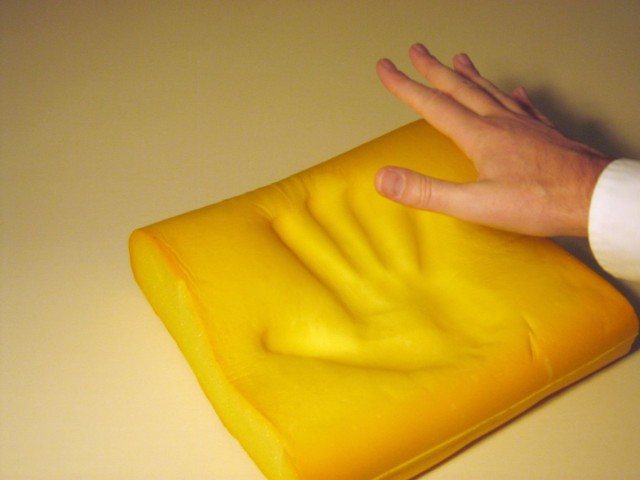

The photo shows an imprint of the shape of a hand after pressing on the viscoelastic polyurethane foam with "memory" - the effect lasts for a few seconds.
Video about the production of furniture foam rubber at the Russian plant SIBPLAST:
More about polyurethane foam
When at the end of the 30s of the XIX century, that is, almost two hundred years ago, German physicists working for the Bayer concern worked on the development of polyurethane elastomers, they could not even think that the final product obtained as a result of experiments, containing unwanted gas bubbles, would become a new step in the evolution of polymer materials. Scientists began to purposefully combine polyhydric alcohols with multifunctional isocyantes. This is how foam with a cellular structure appeared. Subsequent experiments and experiments led to the formation of the final product - polyurethane foam.
In fact, polyurethane foam (PUF) is a mass-use engineering plastic that can be used for a variety of purposes.
Different types of polyurethane foam are based on polyesters or simple polyesters (PE). So, on the basis of complex PE in the middle of the last century, foam plastics with elastic properties began to be developed. A few years later, the first foams based on polyethers appeared. The scope of PPU gradually expanded, and by the end of the 90s PPU were actively used everywhere. Moreover, about 70% of the total volume of produced polyurethane foam was used in the manufacture of upholstered furniture and mattresses.
When choosing a certain type of polyurethane foam for upholstered furniture, its main characteristics matter: the degree of rigidity, weight, elasticity, shock-absorbing properties. All these qualities depend on what starting products and formulations are used in the production of polyurethane foam.
According to the degree of hardness, elastic polyurethane foam can be super soft (from 0.5 kPa), soft, standard or hard. There is also ultra-rigid polyurethane foam (up to 10 kPa). Rigid polyurethane foam is able to replace spring blocks, and soft polyurethane foam sheets of small thickness are usually used in combination with other materials.
There are two ways to produce flexible PU foam. In the manufacture of molded polyurethane foams, each piece is molded separately. In the production of block polyurethane foams, the final product is large rectangular or cylindrical blocks, which are then cut into blanks.
When choosing a specific type of block elastic polyurethane foam for the manufacture of upholstered furniture, concepts such as the rigidity of the material and its apparent density are of paramount importance. Rigidity is the ability of a material to resist deformation. The apparent density is determined by the bulk density of the porous material. Stiffness and apparent density are closely related: the higher the density of the material, the better the foam and the higher the limit of its "fatigue". That is, the higher the load is assumed on a certain section of furniture, the higher the apparent density should be. With a successfully verified combination of the apparent density and rigidity of the material, you can achieve high quality upholstered furniture.
Practice shows that the following options for selecting PPU for various elements of upholstered furniture can be considered the most successful. For seats that experience constant high loads, the density of PU foam should be at least 28-30 kg / m3. For armrests and backs, which have a much lower load, you can use polyurethane foam with a slightly lower apparent density (23-25 kg / m3). The highest degree of apparent density is required for PU foam used in the manufacture of thin flooring in seats (not less than 35 kg / m3) and in backs and armrests (not less than 28 kg / m3). The reason is that the less the thickness of the flooring, the more it lends itself to deformation.
The degree of elasticity of polyurethane foam is determined based on the size of the area of the hysteresis loop under the influence of the load. The smaller the loop, the more elastic the material, and, therefore, the faster it will return to its original shape after the load has disappeared. Block polyurethane foam have ample opportunities in terms of the selection of the degree of elasticity. This makes it possible to combine floorings from materials of varying degrees of elasticity, which exactly correspond to the specified parameters.
Block elastic polyurethane foam is especially good in the manufacture of mattresses. The reason is high air permeability, excellent moisture and heat exchange, low weight of this material. However, it should be remembered that the apparent density of the polyurethane foam used in the manufacture of the mattress should be at least 30-35 kg / m3. This is necessary so that the cells of the polyurethane foam are not deformed and moisture and air exchange are not disturbed inside the product.
Block PPUs have a lot of advantages.They are durable as a material for the manufacture of furniture (especially those developed on the basis of polyethers), resistant to aging, moisture and temperature extremes. In addition, block polyurethane foam meets the highest sanitary and hygienic requirements. Numerous studies have proven the absolute safety of block polyurethane foam for human health. The only drawback of block polyurethane foam (especially with a density less than 30 kg / cubic meter), which should be remembered, is that the material may lose its original properties when restored after excessive compression. This means that special care should be taken when storing and transporting products containing block polyurethane foam.
Molded polyurethane foam is used in the manufacture of complex and bulky soft furniture elements. Each part is produced in an individual mold. At the same time, the production accuracy is so high that it does not require further refinement. Molded polyurethane foam parts have a much higher density than block polyurethane foam parts with similar characteristics. The density of the material for the backs of sofas and armchairs is not less than 42 kg / m3, for the seats - not less than 45-48 kg / m3. In office furniture, where the thickness of the soft element is very small, and the requirements for wear resistance are quite high, polyurethane foam with a density of 55 - 70 kg / m3 is used.
PU foam has a high adhesive ability to almost any material. Thus, in the molding method, spring blocks, metal frames and other parts can be used simultaneously with PU foam. Thus, the process of making upholstered furniture is greatly simplified: in one operation, you can get a completely finished unit.
Today, the main flooring material in the manufacture of upholstered furniture remains a cheaper block polyurethane foam.
Additionally, you can read about the chemical structure and applications of polyurethane foam on Wikipedia.
Challenges and solutions
Standard polyurethane foam sheets, roll foam materials, fire-resistant or viscoelastic foams with a complex structure - each type of product presented on penopoliuretan-spb.ru has certain technical parameters and is designed to solve a specific problem. Some fillers are used for furniture production, others in the construction industry, and others to improve sound insulation of premises. But there are those that have a wide range of applications, and it is most difficult to decide on the choice of products from this category.
Which polyurethane foam to choose, each buyer decides for himself, based on the goals he wants to achieve and the available budget. But sometimes, before making a purchase, it will be useful to find out what well-known companies take to solve similar problems and what recommendations are given by specialists for each type of foamed polyurethane. To do this, simply go to the page of "your" task, for example, "PU foam for a mattress" or "Foam rubber for noise insulation in residential buildings."
General properties
Polyurethane foam and foam rubber belong to a large chemical group polyurethane foams... They are produced on the basis of polyesters... When properly manufactured and used, the materials are completely environmentally friendly and safe for living organisms.
Polyurethane foams are widely used in various fields of activity, depending on the composition, technical characteristics and shape. The material is most in demand in everyday life, construction and industry.
General specifications:
- Density - 30-300 kg / m3.
- Temperature range - from -60 to +80 ° C.
- Electric current non-conductivity.
- Light weight.
- Ozone resistance.
- Resistance to chemical reagents (acids, alkalis, solvents, etc.).
- Air permeability.
- Low resistance to twisting.
In production, 3 main casting technologies are used:
- Rotary - covering of large objects and cylindrical elements.
- Free - the creation of complex heavy forms.
- Under pressure - used for large-scale production of parts.
The chemical composition prevents the reproduction of insects, rodents and the development of microorganisms.
Polyurethane foam (rigid polyurethane foam)
The material is a variety gas-filled plastics... 85-90% consists of inert gas phase... Polyurethane foam is a synthetic insulation with a cellular structure.
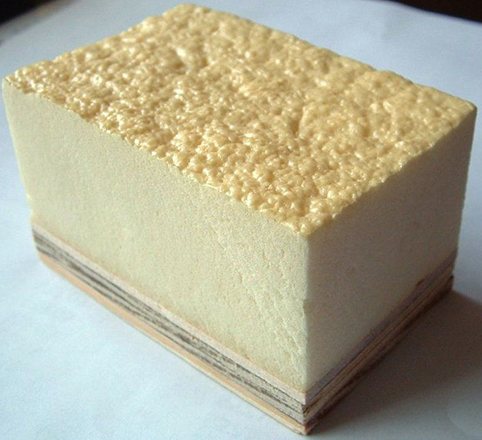

Technical properties:
- Thermal conductivity - 0.019 - 0.035 W / m * K.
- Density - 45-60 kg / m3.
- Water absorption - 1.2-2.1%.
- Destructive - 0.15-1 MPa (compression) and 0.35-1.9 MPa (bending).
- The number of closed pores (85-95 and more).
- Flammability is a category of hardly combustible substances.
Polyurethane foam is used for thermal insulation of residential and industrial buildings... The product fits snugly to horizontal and vertical flat surfaces. Replacement of material is not required throughout the entire life of the building. Polyurethane foam is suitable for thermal insulation of floors, walls, ceilings.
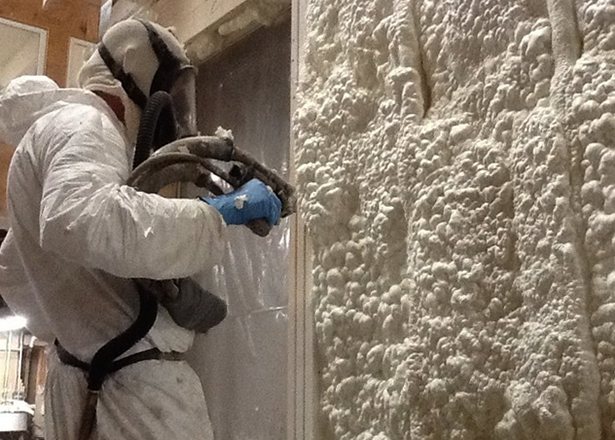

The minimum service life is 25-30 years old... Chemical reagents (solvents, softeners, mineral oil, fuel, acids, alkalis) cannot destroy the structure, since the cells in it are closed. The product is resistant to the appearance of rodents and insects, the development of fungus, mold and microbes. Foreign elements do not penetrate into the structure.



